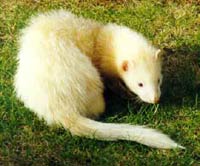|
The introduction by man of myxomatosis into the
wild UK rabbit population in 1953 was another method tried but
although it decimated the population, it inflicted an even slower
and more painful looking death on the rabbit.
The use of ferrets to control rabbits in the following manner
is one of the most humane and environmentally friendly methods
that can be used.
When using ferrets the rabbit holes are covered with small purse
nets fixed to the ground with a small wooden peg. They
are so called because they act like a simple purse in that a nylon
draw cord is fed around the outer edge of the net, passing through
a metal ring fixed at each end, then both ends of the cord are
tied to the peg. This has the effect of closing the net behind
the rabbit.
The ferret is introduced into one of the holes and although a
completely domesticated animal they have retained the instinct
of their ancestor and will hunt through every nook
and crannie within that warren, using their highly developed senses
of hearing and scent to locate any rabbits present. Good eyesight
is not required in this underground environment and albino
ferrets are often used and even preferred by many who claim they
are more easily spotted after emerging from underground and less
likely to wander away.
The rabbit, with the ferret behind it, will bolt out of the nearest
exit hole and be caught in the purse net. They are then despatched
quickly by the ferret owner. Unlike shot rabbits these ones are
ideal for the pot and are delicious done in a casserole with carrots
and shallots, much more tasty that those bland large Dutch rabbits
that are now being sold in supermarkets and even in some butchers
shops.
Purse nets can be dispensed with and the rabbits despatched with
a shotgun and this is sometimes the only way to
clear some warrens that are overgrown with brambles and other
dense undergrowth. These shot rabbits are not really suitable
for eating as the lead shot often punctures the gut and bladder,
contaminating the meat. However they are ideal for feeding to
the ferrets after they have been paunched, with
the stomach and gut removed. Some of the fur is also eaten with
the meat, providing a good source of roughage and, like the ingestion
of feathers when dead poultry or other birds are fed, is what
the ferret's intestines are designed to cope with. The bones also
keep their teeth in good condition and provide a valuable source
of calcium.
Despite my mention elsewhere of the new proprietary complete ferret
dry foods, this natural diet cannot be improved on. Nowhere will
this be more obvious than when cleaning out the dung corner. The
ferret stools on this diet are non sticky, thin and black and
contain some fur and feather. While not going as far as to say
they are a pleasure to clean out, they are when compared to the
soft sticky mess that is produced by artificial foods.
Lurcher or other running type dogs are used by some to chase and
catch the bolting rabbits but this practice looks likely to be
outlawed in the UK under the proposed ban on hunting with dogs.
A more recent development is the use of a bird of prey
to chase and swoop on the bolting rabbits and looks like becoming
even more popular, with large professional bodies now offering
package type hunting weekends to interested parties.
|

